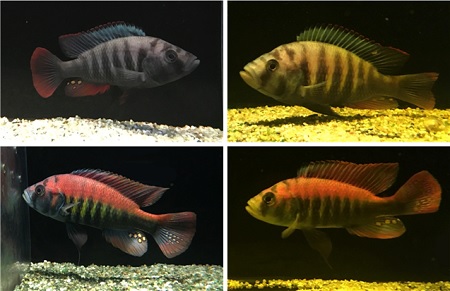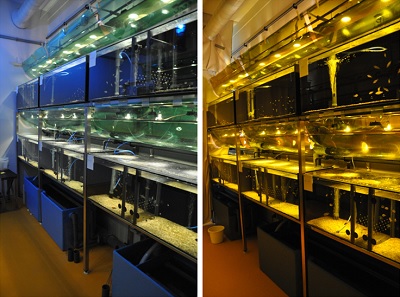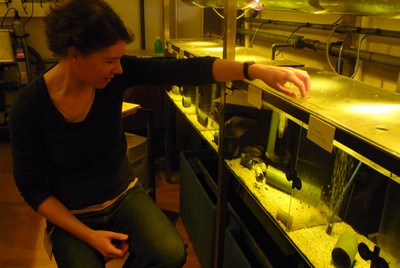Vision drives cichlid evolution
The cichlids of Lake Victoria are a textbook example of rapid evolution. When conditions changed, new species developed at breakneck speed. Biologists suspect that the visual environment underwater (light and turbidity) is an important driver in the formation of new species, but direct evidence has been hard to come by. Now supporting evidence has emerged from the University of Groningen aquariums. The results were published in The American Naturalist.

Dozens of fish tanks line the room in the Linnaeusborg that is home to University of Groningen biologists. The light over the tanks is whitish and resembles daylight. Inside the tanks are cichlids, originating from Lake Victoria, Africa’s largest lake. The next room contains similar tanks, but the light there is more yellow. ‘The blue is filtered out to reproduce conditions at a depth of five metres’, explains University of Groningen evolutionary biologist Martine Maan. ‘The white light resembles conditions in the upper regions.’
Maan uses the fish to test her ideas on cichlid evolution. In 2008, she and colleagues from other institutions published an article in the journal Nature on how changes in the opsin gene (coding for light sensitive proteins in the retina) drive evolution in cichlids. They noted that opsin genes differed more between species in clear water than between species in turbid water. ‘But there are more factors, like partner preference. So the question was: what comes first?’

Plasticity
Together with colleagues from the Eawag Institute and University of Bern (both in Switzerland), Maan set up an experiment with two related species of cichlid. One has a blue dorsal fin and lives near the surface and the other is reddish and lives at a depth of around five metres. ‘The blue species is common throughout the lake, but we believe the red species has split off separately to different areas, although there is some gene flow between the red populations’, Maan explains.
She started to breed the two species in the lab, and also produced hybrids. Female cichlids brood the eggs in their mouths. Just before the eggs hatched, Maan divided the broods into two groups: one that she raised under light conditions resembling those near the surface and the other that she exposed to ‘deep water’ light. ‘There is some plasticity in the eye during development, so I wanted to see its effect on fish behaviour.’
In the experiment, Maan kept track of the fish by chipping them. ‘That’s how I noticed a difference in survival between the groups.’ The fish that were living in the ‘wrong’ lighting conditions had a decreased survival rate. ‘This was true for the blue and red species, but the hybrids survived equally well in both conditions.’
Aggressive
This is the first time a direct link has been found between the visual system and fitness of cichlids. ‘We had clues from correlations, but no direct measurements. Now, we can see that the visual system of these fish does indeed adapt to specific lighting conditions and that this affects their survival.’ This shows that changes in the visual system can be the first step in speciation, as they affect survival separately from, for example, sexual selection.
Why survival is reduced in fish with the ‘wrong’ visual system is unclear. ‘My guess would be that it has to do with social interaction. These cichlids are very aggressive, so the bigger individuals in a tank will outcompete the smaller ones. When kept in isolation, they live much longer.’ Maan is currently testing if the ‘wrong’ visual system makes it more difficult for the fish to catch live prey (mosquito larvae). ‘We are also still analysing how the fish’s retinas change in response to the different light conditions. But the survival data strongly suggests that plasticity cannot fully compensate for the genetic differences in visual characteristics.’
Reference: Martine E. Maan, Ole Seehausen, en Ton G. G. Groothuis: Differential Survival between Visual Environments Supports a Role of Divergent Sensory Drive in Cichlid Fish Speciation. The American Naturalist, Online publcation ahead of print, doi: 10.1086/689605
| Last modified: | 12 March 2020 10.15 p.m. |
More news
-
23 April 2024
Nine MSCA Doctoral Network grants for FSE researchers
Nine researchers of the Faculty of Science and Engineering have received a Horizon Europe Marie Sklodowska Curie Doctoral Network grant.
-
22 April 2024
Charissa Roossien secures JTF subsidy to develop Health Tracker
Dr. Charissa Roossien (ENTEG) has successfully secured a Just Transition Fund (JTF) subsidy of 1.8 million euros to develop a Health Tracker for reliable respiratory and metabolic analysis.
-
16 April 2024
UG signs Barcelona Declaration on Open Research Information
In a significant stride toward advancing responsible research assessment and open science, the University of Groningen has officially signed the Barcelona Declaration on Open Research Information.

